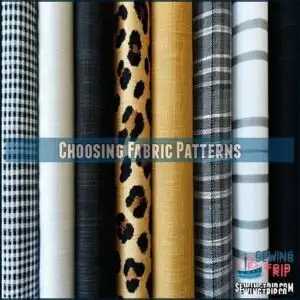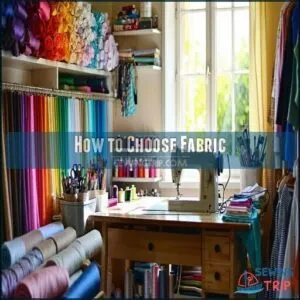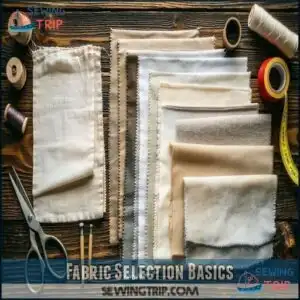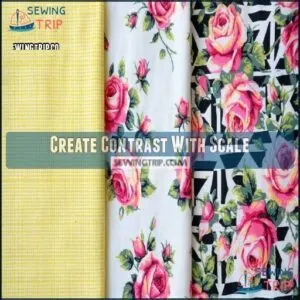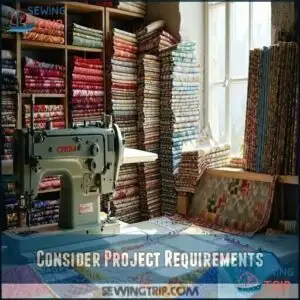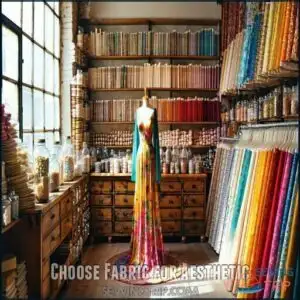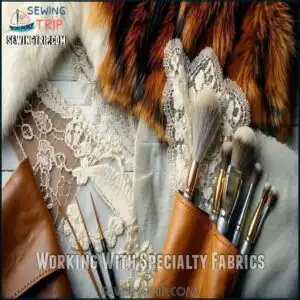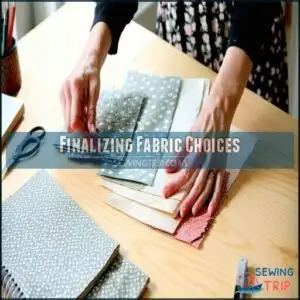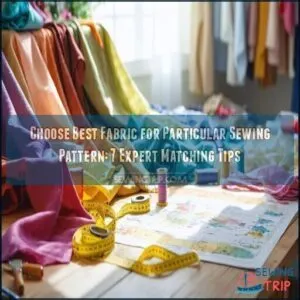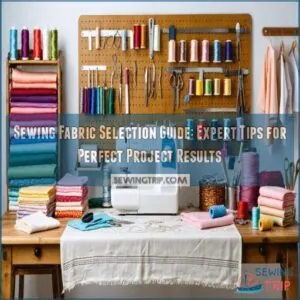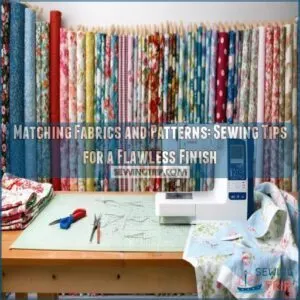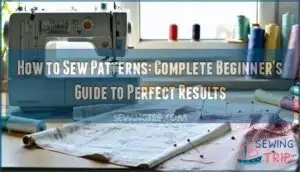This site is supported by our readers. We may earn a commission, at no cost to you, if you purchase through links.
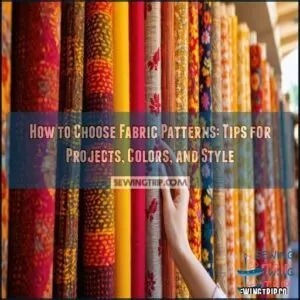
Mix scales—pair larger prints with medium and small patterns to create visual interest without causing a "fabric fight."
Consider your project’s purpose; upholstery demands sturdier patterns than a summer dress.
Don’t forget to balance busy prints with solids or subtle textures, giving your eyes a place to rest, which is part of the science of combining patterns.
Like mixing a perfect cocktail, combining patterns is part intuition.
Hold fabrics together in natural light to see how they truly interact, and you might find the perfect pattern combination is hiding in plain sight, waiting for your creative touch.
Table Of Contents
Key Takeaways
- You’ll create more visually appealing projects when you establish a color scheme first, using one dominant hue as your anchor while maintaining consistent vibrancy throughout your palette.
- You should mix patterns of different scales—pairing larger prints with medium and small patterns—to create visual interest without causing competing elements that overwhelm the eye.
- Your project’s purpose should guide your fabric selection, as upholstery requires more durable patterns than clothing, and you’ll need to match fabric weight and properties to your specific needs.
- You’ll achieve better balance in your designs when you pair busy prints with solids or subtle textures, giving the eye a place to rest while maintaining the visual harmony of your project.
Choosing Fabric Patterns
You’ll find that choosing the right fabric patterns can transform your project from ordinary to eye-catching, much like finding the perfect accessory for an outfit.
When you’re selecting patterns, consider how colors, scales, and textures will work together, and don’t be afraid to mix a tiny cheetah print with a classic stripe for that perfect balance of interest and harmony, achieving a perfect balance and creating a visually appealing eye-catching project.
Consider Color Palette
When selecting fabrics for your project, color palette consideration can make or break your design.
You’ll want to establish color harmony by choosing complementary or analogous combinations. Don’t be afraid to mix tone variations for depth—just maintain consistent vibrancy (either warm or cool).
Remember that a single print can inspire your entire color coordination scheme.
For vibrant contrasts that pop, try pairing complementary colors, while neutralizing prints with solids creates balanced color distribution.
Think About Fabric Scale
Fabric scale acts as the unsung hero of successful project design.
When choosing patterns, think about how the size of prints affects your overall look.
- Large-scale prints create bold statements but need breathing room to shine
- Small-scale fabrics work better for tiny pieces where pattern clarity matters
- Mixing scales (large, medium, and small) creates visual interest and fabric balance
Remember, pattern density dramatically impacts your project’s final appearance.
Personal Preference Matters
While fabric scale impacts your project’s visual balance, your personal preferences should ultimately guide your fabric pattern selection.
Trust your intuition rather than rigidly following design rules. What catches your eye and makes you smile matters most in the creative process.
Your unique expression through fabric choices builds confidence in your individual style over time. Don’t be afraid to embrace experimentation – sometimes the most unexpected style preferences lead to stunning results.
How to Choose Fabric
You’ll transform your sewing projects from ho-hum to spectacular when you match the right fabric to your needs, considering both purpose and properties.
Whether you’re wrestling with slippery silk or befriending cozy cotton, choosing fabric that suits your skill level and project requirements is the foundation of crafting success.
Determine Project Purpose
The foundation of smart fabric pattern selection begins with your project’s purpose.
Before diving into the sea of fabric choices, clarify what you’re creating.
- Project Goals: Will your creation be decorative or functional?
- Intended Use: Is it for everyday wear or special occasions?
- Durability Needs: How much wear and tear will it endure?
- Aesthetic Vision: What feeling should your finished project evoke?
Understanding these elements will narrow your fabric patterns substantially.
Consider how to align your choices with fabric project goals to achieve your project’s purpose, and ensure it meets your aesthetic vision, is suitable for its intended use, and has the required durability needs.
Assess Skill Level
Many beginners jump into fabric projects only to find themselves tangled in frustration with fabrics beyond their skill level.
You’ll want to honestly assess your abilities before choosing patterns.
| Skill Level | Best Fabrics | Project Complexity |
|---|---|---|
| Beginner | Cotton, felt | Simple patterns, minimal matching |
| Intermediate | Linen, denim | Some pattern matching required |
| Advanced | Silk, velvet | Complex pattern matching, intricate designs |
Remember, it’s better to master simpler fabrics before tackling slippery silks or pattern matching nightmares!
Evaluate Fabric Properties
Now that you’ve assessed your skill level, let’s examine what makes fabrics tick.
When you touch a fabric, you’re actually evaluating several key properties. Fiber content determines how it behaves, weave structure affects durability, and drape quality shows how it’ll hang on your project.
Don’t forget to check fabric weight and perform a quick texture analysis—is it stiff or flowing?
Woven fabrics and linen fabrics have distinct fabric properties that impact your final creation, considering factors like fiber content and overall fabric weight.
Fabric Selection Basics
You’ll save yourself hours of frustration and potential project disasters by getting comfortable with fabric types, weights, and textures before your first cut.
Understanding these basics is like learning the alphabet before writing a novel, and trust me, your sewing machine will thank you for not trying to force silk through it when the pattern calls for cotton.
Understand Fabric Types
Now that you’ve determined your project’s purpose, let’s get to know the fabric types you’ll be working with.
Understanding different fabrics is like having a map before starting a journey!
Natural fibers, synthetic options, and blended fabrics each bring unique qualities to your projects:
- Natural fibers (cotton, silk, wool, linen) offer breathability and comfort
- Synthetic options (polyester, nylon) provide durability and easy care
- Blended fabrics combine the best of both worlds with enhanced performance
Knowing these fabric types helps you match your material to your vision!
Learn About Fabric Weights
Now that you know the basic fabric types, let’s weigh in on another important factor—literally! Fabric weight, measured in GSM (grams per square meter) or ounces per yard, substantially affects your project’s drape and stability.
Your fabric weight choices are generally categorized into three groups: lightweight fabrics (under 150 GSM) that flow beautifully for delicate projects, medium-weights (150-350 GSM) that offer versatility, while heavyweights (over 350 GSM) provide structure.
Your needle choice should match—thinner for light fabrics, sturdier for heavy materials.
Consider Fabric Texture
When selecting fabrics, don’t overlook texture as it plays a vital role in your project’s overall feel.
Texture adds visual weight and tactile appeal that can transform even simple designs.
You’ll find that smooth satins drape differently than crisp cottons, while nubby linens create surface interest that flat fabrics can’t match.
Consider how pattern texture complements design texture—sometimes contrasting fabric textures creates the perfect balance for your creative vision.
Coordinating Fabric Patterns
You’ll find that mixing fabric patterns doesn’t have to feel like solving a puzzle with missing pieces, as the key lies in balancing scale, color, and contrast for visual harmony.
Creating a cohesive look means pairing busy prints with simple ones, varying the pattern sizes, and maintaining a consistent color palette throughout your project to achieve visual harmony.
Use Pre-Coordinated Collections
Pre-coordinated fabric collections are a lifesaver when you’re overwhelmed by endless color combinations.
They’re designer curated to take the guesswork out of fabric selection.
Here’s why collections are worth considering:
- Time saving – no more agonizing over coordinating shapes
- Beginner friendly – perfect for those lacking confidence
- Harmonious palettes – built-in contrast and scale variety
- Collection benefits include pre-established coordination that simply works, providing a time saving and harmonious experience.
Create Contrast With Scale
While collections make color coordination simpler, playing with scale adds dimension to your fabric combinations.
Creating contrast with different print sizes prevents your project from falling flat.
| Scale Type | Visual Effect | Best Used For |
|---|---|---|
| Small | Creates texture | Background, fillers |
| Medium | Provides balance | Main components |
| Large | Makes statements | Focal points |
Varying scale establishes visual balance and fabric depth.
Understanding fabric grain alignment is also essential for preventing distortions.
Try combining a tiny dot print with medium florals and one large-scale showstopper for pattern contrast that makes your project pop!
Balance Busy Prints
While varying scale creates visual interest, you’ll also need to balance busy prints.
When working with bold geometric patterns or intricate florals, pair them with fabrics that provide visual rest.
Small-scale prints or "blenders" work like palate cleansers between statement pieces.
Distribute colors evenly throughout your project, and consider adding solid fabrics to neutralize overly busy sections.
Texture contrast can also help tame abstract patterns without sacrificing personality.
Selecting Fabric for Projects
You’ll save yourself a mountain of crafting headaches when you match your fabric to your project’s specific needs, considering both practical requirements and your personal style.
Whether you’re making a pillow that’ll face the daily assault of family movie nights or a special occasion dress, choosing the right fabric can mean the difference between a creation you proudly display and one that gets quietly tucked away in the "learning experience" drawer, which can be a result of not considering the practical requirements.
Consider Project Requirements
Now that you’ve got your patterns coordinated, it’s time to match them with your specific project.
Every project has its own set of demands—a baby quilt requires different fabric than a sofa slipcover. Consider your pattern complexity and fabric compatibility before cutting.
Will your chosen fabric work with your garment’s design? Remember that intricate patterns might get lost in complex project designs, while simple projects can showcase bold pattern scales beautifully.
Many quilters find inspiration in various quilt fabrics, and it is essential to choose the right fabric for your project to ensure the best visual outcome and fabric compatibility.
Think About Fabric Durability
Now that you’ve identified your project’s requirements, let’s talk durability. You’ll want fabric that stands up to your intended use.
Cotton duck can handle the rough-and-tumble of a playroom sofa, while delicate silk won’t survive the daily wear and tear of kitchen napkins.
Consider how often you’ll clean the item—some fabrics lose their luster after frequent washing. Check fiber strength and abrasion resistance ratings for high-traffic items like cushions or bags.
For enhanced longevity, consider fabrics with tight weaves.
Choose Fabric for Aesthetic
Beyond durability, your fabric should tell your aesthetic story and create the visual impact you want.
When selecting fabric patterns for style, consider how they’ll transform your project’s overall look and feel.
- Look for Pattern Purpose – choose patterns that enhance your design goals
- Consider Scale Harmony with your project size
- Create Texture Contrast for visual interest
- Maintain Print Balance between busy and calm areas
- Add Zinger Fabrics as unexpected accent elements
The right fabric pattern doesn’t just last—it speaks your design language and brings your vision to life, creating a unique visual impact.
Working With Specialty Fabrics
You’ll find that specialty fabrics like lace, leather, and faux fur each have their own quirks that’ll test your sewing skills, but don’t worry—they’re not as scary as that time I tried to sew velvet upside down.
When you’re working with these unique materials, you’ll need specific techniques and tools, such as leather needles or walking feet, to achieve professional results without pulling your hair out.
Learn About Performance Fabrics
When selecting fabric for projects, performance fabrics offer exceptional benefits you shouldn’t overlook.
These high-tech textiles are engineered for durability, with tightly woven fibers that resist stains, fading, and wear.
You’ll appreciate their water resistance and mold-fighting properties, making them perfect for both indoor and outdoor applications.
Fabric durability is substantially enhanced through specialty weave types that maintain their appearance despite heavy use.
They’re versatile enough for furniture, clothing, and commercial spaces where textile performance matters most.
For activewear, consider fabrics with enhanced dryness and breathability for ideal comfort.
Understand Lace and Leather
While performance fabrics revolutionize function, lace and leather offer unique texture contrast in your projects.
Lace adds delicate elegance with varying durability depending on construction—perfect for overlays and accents.
Leather brings rugged sophistication but requires special handling techniques like leather lacing, which is more durable than traditional stitching.
You can find various types available for your projects.
When selecting these specialty fabrics, consider ethical sourcing options and leather alternatives if sustainability matters to you.
Your fabric choice dramatically impacts the final character of your creation.
Explore Faux Fur Options
When adding faux fur to your project, you’re embracing a cruelty-free, vegan option that’s incredibly versatile.
Today’s synthetic furs come in various pile length options, from short and sleek to long and luxurious.
Beyond just fashion, consider using faux fur for home decor like throws and pillows.
Remember that fabric patterns matter less with fur—it’s the texture that becomes your pattern design statement.
Most fabric stores now offer eco-friendly versions with reduced environmental impact, making it a great choice for those looking for a versatile option.
Finalizing Fabric Choices
You’ve done all the hard work of narrowing down your fabric options, and now it’s time to make those final choices that’ll turn your project from a pile of possibilities into a masterpiece.
Don’t worry if you need to switch things up as you go along, even the most seasoned crafters often find themselves making mid-project adjustments when they see how fabrics actually play together in real life, which can be a valuable learning experience.
Visualize Fabric Interactions
Testing fabric combinations before committing can save you time and heartache.
Try sketching fabrics together or using software simulations to see how patterns play with each other.
Pin fabric swatches on a design wall and step back—you’ll be surprised how different they look from a distance!
Photography aids like black and white photos can reveal value contrasts that your eyes might miss.
Plan Fabric Placement
Before cutting into your precious fabrics, map out your pattern placement with intention.
Consider block arrangement and value distribution to create visual harmony. Group similar colors together or try strategic print repeats throughout your project.
A quick sketch visualization can prevent costly mistakes and help you achieve a cohesive look.
When mixing patterns, remember that fabric pattern matching isn’t about perfection—it’s about creating a pleasing rhythm that reflects your personal pattern style.
Be Open to Design Changes
Now that you’ve planned your fabric placement, remember that some of the best design choices happen when you’re willing to change course. Even experienced crafters rarely stick to their original plan!
Fabric weight impacts the drape, so consider pattern fabric recommendations before cutting.
Here are five ways to embrace mid-project shifts:
- Trust your intuition when something doesn’t look right
- Take photos to view your work from a different perspective
- Experiment freely with pattern mixing before final commitment
- Keep extra fabric on hand for unexpected design decisions
- Remember that "mistakes" often lead to unique, personal touches
Frequently Asked Questions (FAQs)
How do I know what fabric to use for a pattern?
When Sarah made her first dress, she discovered fabric weight matters most.
Check the pattern’s recommendations, match fabric drape to the garment’s intended look, and consider the fiber content for comfort and care.
What are the 4 things to consider when choosing fabric?
When choosing fabric, you’ll want to keep in mind: the weight and drape, fiber content and performance requirements.
The scale of pattern (if any), and how well it suits your project’s purpose and difficulty level.
How do you coordinate fabric patterns?
To coordinate fabric patterns, pair large-scale prints with medium and small-scale designs for balance.
Mix solids with patterned fabrics, maintain consistent color vibrancy, and make certain textures complement each other.
You’ll create harmonious, visually interesting combinations, with a focus on balance.
How to choose the right fabric for your project?
Like threading a needle with purpose, consider your project’s function first.
Match fabric weight to your pattern, evaluate durability needs, and choose materials that suit both your skill level and desired aesthetic outcome.
How to match fabric patterns across rooms?
You’ll want to repeat color elements, vary pattern scales, and maintain consistent vibrancy across rooms.
Connect spaces using a signature pattern as an accent, while allowing each room to maintain its own personality.
Can I mix vintage and modern patterns?
Like dance partners from different eras, vintage and modern patterns can create beautiful harmony.
You can mix them successfully by balancing scale, using a consistent color palette, and ensuring one style doesn’t overwhelm the other, which allows for beautiful harmony and a consistent color palette.
How to photograph fabrics accurately online?
For accurately photographing fabrics online, shoot in natural daylight, avoid shadows, place a color reference card nearby.
Capture close-ups showing texture, and include something for scale too—a ruler works perfectly!
When should I avoid directional prints?
Nearly 60% of quilters report wasting fabric due to directional print challenges.
You should avoid directional prints when making complex quilt patterns, rotated blocks, or when you’re short on fabric for proper pattern alignment.
Are there cultural considerations for pattern selection?
Cultural considerations are essential when selecting patterns.
Be mindful of tribal or indigenous designs to avoid appropriation.
Instead of simply borrowing traditional motifs, consider supporting native designers directly and understanding the cultural significance behind patterns you’re drawn to.
Many popular designs are actually Dutch wax prints.
Conclusion
Remember, choosing fabric patterns is a journey, not a destination!
Trust your instincts while following these guidelines—build your color palette first, balance scales thoughtfully, and always consider your project’s purpose.
When you’re in doubt, step back and view your fabric combinations in natural light.
With practice, you’ll develop an eye for how to choose fabric patterns that express your unique style while creating harmony in your finished projects.
Happy crafting!

